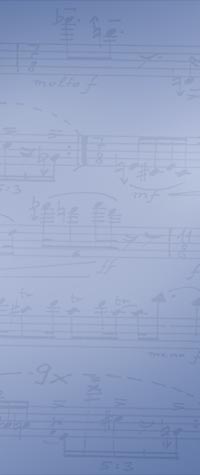
Osm kusů pro kytarové kvarteto (1998)
8 Pieces for Guitar Quartet
- Instrumentation: guitar quartet
- Movements: 8
- Duration: 12'
- Dedicated to: Aleph Gitarrenquartet
- Premiere: 29.10.1999, Konzerte in unserer Stadt 1999/2000, Stuttgart; Aleph Gitarrenquartett (Karlsruhe)
- Publisher: none (available from composer)
Program Note:
(DE)
Ein Paradox der Gitarre: Wenn sie leise gespielt wird, klingt sie sehr voll. Und während das Ohr den zarten Klängen zuhört, öffnet es sich subtilen Unterschieden. Indem ich diese Idee verfolgte, gelangte ich nicht nur zum pianissimo, sondern auch zu extrem einfachen musikalischen Situationen und daran versteckten Variationen.
Die Situationen:
- nur eine Note (Nr. II)
- nur ein Akkord (Nr. IV)
- nur der Umfang einer kleinen Terz (Nr. I, III)
- ein uhrenartiges Ticken (Nr. V, VI)
- eine eintaktige Melodie (Nr. VII)
- ein Arpeggio (Nr. VIII)
Die verstecken Variationen:
- seitliches Ziehen der Saite, das in 7 Mikrointervalle unterteilt ist
- ein Cluster wird wiederholt; jedoch sind die 12 Töne jedes Mal neu zwischen den Instrumenten verteilt und zwar so, daß die einzelne Gitarre zwischen tonalen Akkorden und Halbtonclustern wechselt
- die Töne einer Melodie sind in variierender Folge Hoquetus - artig auf die Gitarren verteilt
- die gleiche Tonhöhe wird jedes Mal auf einer anderen Saite oder mit einem andern Oberton gespielt
- etc.
Übrigens: Das sechste Stück beginnt, während das fünfte noch läuft - für eine Weile erklingen beide.
Martin Smolka
(EN)
8 pieces for guitar quartet are based on the guitar's acoustic paradox: the softer you play, the richer tone quality and modulation possibilities you get. Consequently with the dynamics I diminished many other musical parametres to almost zero. Eight short movements in it's way re-constitutes the basic elements of music's identity such as melody, rhythm, repetition and chord. There are variations on:
- one single tone (by bending it slightly - No. II)
- one single chord (No. IV)
- few repeated tones (showing them in delicate color differencies - No. V, VII)
- one cluster (changing still it's inner structure - No. VI)
- one short melody (hoqueting it each time differently - No. VII)
- one arpeggio (No. VIII)
The idea of diminution concerns also the ensemble (the 4 guitars often sound like one instrument), a range (with one exception the two low strings never play) etc. - the whole piece is quite ascetic. Although it's emotional range is not wide, the piece is rich in gentle mood nuances - such as guitar is rich in color when played softly.
Martin Smolka
(FR)
8 pièces pour quatuor de guitares est basé sur le paradoxe acoustique de la guitare : plus l'on joue piano, plus les possibilités de modulations et de richesses tonales sont grandes. En conséquence, avec les dynamiques, je diminue au niveau presque zéro de nombreux autres paramètres musicaux. Huit mouvements courts reconstituent les éléments basiques de l'identité musicale, tels que la mélodie, le rythme, la répétition et l'harmonie. Les variations ont lieu sur :
- Une seule note (en la courbant doucement - No. II)
- Un seul accord (No. IV)
- Quelques notes répétées (les montrant dans de différentes couleurs délicates - No. V, VII)
- Une mesure (changeant sa structure interne - No. VI)
- Une courte mélodie (la chantonnant chaque fois de manière différente - No. VII)
- Un arpège (No. VIII)
L'idée de diminution concerne aussi l'ensemble (les quatre guitares sonnent souvent comme un instrument), une étendue (avec une exception, les deux cordes basses ne jouent jamais), etc. La pièce toute entière est comme ascétique. Bien que son ambitus émotionnel soit restreint, la pièce est riche en nuances subtiles, de même qu'est riche la couleur de la guitare lorsqu'elle est jouée piano.
Martin Smolka
(SI)
Paradoks kitare je v tem, da zveni najbolj polno takrat, ko igramo nanjo zelo tiho. In medtem ko uho prisluhne tem nežnim zvokom, se odpre zaznavi subtilnih razlik. S tem ko sem sledil tej zamisli, nisem pristal le v pianissimu, ampak tudi v skrajno preprostih glasbenih položajih in njihovih prikritih variacijah. Položaji:
– samo en notni zapis (št. II)
– samo en akord (št. IV)
– obseg ene same male terce (I, III)
– kot tiktakanje ure (V, VI)
– enotaktna melodija (VII)
– en sam arpeggio (VIII)
Skrite variacije:
– napenjanje strune v stran, ki je razdeljena na 6 mikrointervalov
– »cluster«, ki se ponavlja, vendar vedno drugače "porazdeljen" med 4 inštrumente; posamezna kitara menjuje pri tem tonalne akorde s poltonskimi »clustri«
– toni ene in iste melodije so v variiranem sosledju "Hoquetus" (menjajoče skakajoč) razporejeni med inštrumente
– en in isti ton, vsakič zaigran na drugi struni ali kot drugi flažolet
Sicer pa: Šesti stavek začne, ko peti še teče, nekaj časa zvenita skupaj.
Martin Smolka
Reviews:
Jan Topolski, Ruch Muzyczny, Rok LII Nr 23
(...) Jakże ekspresyjne mogą być mikrotony! Dziwne, że w zachwytach nad twórczością Partcha, Griseya, Radulescu, a ostatnio Mazulisa nigdy tego tak nie odczułem. Tu ewokują one całą skalę uczuć, ale głównie melancholii, smutku, rozdarcia. Smolka używa paru prostych modi, z których jedno eksponowane jest w pierwszym utworze. Jak zwykle w jego "muzyce ubogiej" dużą rolę pełni cisza, pojmowana jako brak, pustka (...). Ta filigranowa muzyka rozgrywa się w delikatnie tkanych pajęczynach ostinat, rezonansów, akordów, rzadko osiągając pełnię brzmienia albo wyższy poziom dynamiki. I w tym właśnie tkwi jej siła wyrazu. Minimalizm objawia się także w ograniczeniach: druga odsłona to wariacje jednego dźwięku; czwarta - jednego akordu; ósma - jednego arpeggia. A wokół ciągle krążąca melancholia, jakby parafrazując tytuł dawniejszego utworu Czecha - Dést', nejaké okno, strechy, komíny, holubi a tak..., a taky zeleznicní mosty.







 Listen to an mp3 excerpt
Listen to an mp3 excerpt